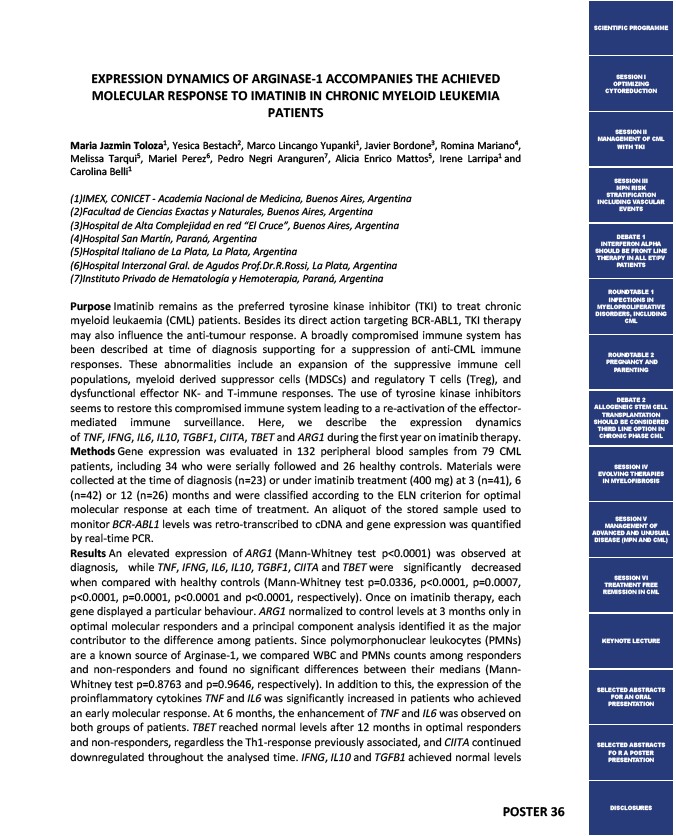
EXPRESSION DYNAMICS OF ARGINASE-1 ACCOMPANIES THE ACHIEVED
MOLECULAR RESPONSE TO IMATINIB IN CHRONIC MYELOID LEUKEMIA
POSTER 36
PATIENTS
Maria Jazmin Toloza1, Yesica Bestach2, Marco Lincango Yupanki1, Javier Bordone3, Romina Mariano4,
Melissa Tarqui5, Mariel Perez6, Pedro Negri Aranguren7, Alicia Enrico Mattos5, Irene Larripa1 and
Carolina Belli1
(1)IMEX, CONICET - Academia Nacional de Medicina, Buenos Aires, Argentina
(2)Facultad de Ciencias Exactas y Naturales, Buenos Aires, Argentina
(3)Hospital de Alta Complejidad en red “El Cruce”, Buenos Aires, Argentina
(4)Hospital San Martín, Paraná, Argentina
(5)Hospital Italiano de La Plata, La Plata, Argentina
(6)Hospital Interzonal Gral. de Agudos Prof.Dr.R.Rossi, La Plata, Argentina
(7)Instituto Privado de Hematología y Hemoterapia, Paraná, Argentina
Purpose Imatinib remains as the preferred tyrosine kinase inhibitor (TKI) to treat chronic
myeloid leukaemia (CML) patients. Besides its direct action targeting BCR-ABL1, TKI therapy
may also influence the anti-tumour response. A broadly compromised immune system has
been described at time of diagnosis supporting for a suppression of anti-CML immune
responses. These abnormalities include an expansion of the suppressive immune cell
populations, myeloid derived suppressor cells (MDSCs) and regulatory T cells (Treg), and
dysfunctional effector NK- and T-immune responses. The use of tyrosine kinase inhibitors
seems to restore this compromised immune system leading to a re-activation of the effector-mediated
immune surveillance. Here, we describe the expression dynamics
of TNF, IFNG, IL6, IL10, TGBF1, CIITA, TBET and ARG1 during the first year on imatinib therapy.
Methods Gene expression was evaluated in 132 peripheral blood samples from 79 CML
patients, including 34 who were serially followed and 26 healthy controls. Materials were
collected at the time of diagnosis (n=23) or under imatinib treatment (400 mg) at 3 (n=41), 6
(n=42) or 12 (n=26) months and were classified according to the ELN criterion for optimal
molecular response at each time of treatment. An aliquot of the stored sample used to
monitor BCR-ABL1 levels was retro-transcribed to cDNA and gene expression was quantified
by real-time PCR.
Results An elevated expression of ARG1 (Mann-Whitney test p<0.0001) was observed at
diagnosis, while TNF, IFNG, IL6, IL10, TGBF1, CIITA and TBET were significantly decreased
when compared with healthy controls (Mann-Whitney test p=0.0336, p<0.0001, p=0.0007,
p<0.0001, p=0.0001, p<0.0001 and p<0.0001, respectively). Once on imatinib therapy, each
gene displayed a particular behaviour. ARG1 normalized to control levels at 3 months only in
optimal molecular responders and a principal component analysis identified it as the major
contributor to the difference among patients. Since polymorphonuclear leukocytes (PMNs)
are a known source of Arginase-1, we compared WBC and PMNs counts among responders
and non-responders and found no significant differences between their medians (Mann-
Whitney test p=0.8763 and p=0.9646, respectively). In addition to this, the expression of the
proinflammatory cytokines TNF and IL6 was significantly increased in patients who achieved
an early molecular response. At 6 months, the enhancement of TNF and IL6 was observed on
both groups of patients. TBET reached normal levels after 12 months in optimal responders
and non-responders, regardless the Th1-response previously associated, and CIITA continued
downregulated throughout the analysed time. IFNG, IL10 and TGFB1 achieved normal levels
SCIENTIFIC PROGRAMME
SESSION I
OPTIMIZING
CYTOREDUCTION
SESSION II
MANAGEMENT OF CML
WITH TKI
SESSION III
MPN RISK
STRATIFICATION
INCLUDING VASCULAR
EVENTS
DEBATE 1
INTERFERON ALPHA
SHOULD BE FRONT LINE
THERAPY IN ALL ET/PV
PATIENTS
ROUNDTABLE 1
INFECTIONS IN
MYELOPROLIFERATIVE
DISORDERS, INCLUDING
CML
ROUNDTABLE 2
PREGNANCY AND
PARENTING
DEBATE 2
ALLOGENEIC STEM CELL
TRANSPLANTATION
SHOULD BE CONSIDERED
THIRD LINE OPTION IN
CHRONIC PHASE CML
SESSION IV
EVOLVING THERAPIES
IN MYELOFIBROSIS
SESSION V
MANAGEMENT OF
ADVANCED AND UNUSUAL
DISEASE (MPN AND CML)
SESSION VI
TREATMENT FREE
REMISSION IN CML
KEYNOTE LECTURE
SELECTED ABSTRACTS
FOR AN ORAL
PRESENTATION
SELECTED ABSTRACTS
FO R A POSTER
PRESENTATION
DISCLOSURES